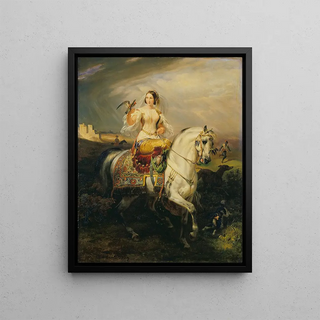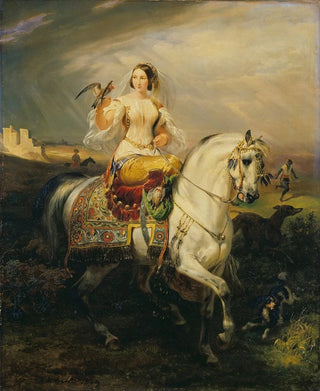Art print | An Algerian lady Hawking - Horace Vernet


View from behind

Frame (optional)
In the fascinating universe of art, some works transcend the simple frame to tell vibrant, emotion-filled stories. "Une dame algérienne Hawking" by Horace Vernet is one of those creations that sparks the imagination and immerses the viewer in a journey through time and space. This piece, which evokes the beauty and complexity of Algerian culture, stands out for its realism and depth. Through this art print, the spirit of the XIXth century blends with a modern vision, offering a window into a rich, colorful past. The work invites contemplation, discovery of a world where art and history meet with rare elegance.
Style and uniqueness of the work
Horace Vernet, master of realism, manages to capture the very essence of his subject with striking precision. "Une dame algérienne Hawking" is characterized by a palette of warm, earthy colors that evoke the landscapes of the Maghreb. The meticulous details of traditional clothing, as well as the gentle and resolute expression of the character, testify to a deep respect for the culture depicted. Vernet does not merely reproduce an image; he creates an atmosphere, an ambiance that transports the viewer to a suspended moment. The posture of the lady, both graceful and strong, suggests a personal story and cultural heritage, making the art print all the more captivating. Every brushstroke seems to tell a part of Algerian life and traditions, inviting total immersion into this universe.
The artist and his influence
Horace Vernet, born in 1789, is an emblematic figure of French art. His artistic journey is marked by a passion for the Orient, influenced by his travels in North Africa. Vernet knew how to translate this fascination into powerful works that blend realism and romanticism. His ability to depict genre scenes and portraits with such intensity has left an indelible mark on 19th-century painting. By choosing to depict Algerian subjects, Vernet not only broadened the horizons of Western art but also contributed to a better understanding

Matte finish

View from behind

Frame (optional)
In the fascinating universe of art, some works transcend the simple frame to tell vibrant, emotion-filled stories. "Une dame algérienne Hawking" by Horace Vernet is one of those creations that sparks the imagination and immerses the viewer in a journey through time and space. This piece, which evokes the beauty and complexity of Algerian culture, stands out for its realism and depth. Through this art print, the spirit of the XIXth century blends with a modern vision, offering a window into a rich, colorful past. The work invites contemplation, discovery of a world where art and history meet with rare elegance.
Style and uniqueness of the work
Horace Vernet, master of realism, manages to capture the very essence of his subject with striking precision. "Une dame algérienne Hawking" is characterized by a palette of warm, earthy colors that evoke the landscapes of the Maghreb. The meticulous details of traditional clothing, as well as the gentle and resolute expression of the character, testify to a deep respect for the culture depicted. Vernet does not merely reproduce an image; he creates an atmosphere, an ambiance that transports the viewer to a suspended moment. The posture of the lady, both graceful and strong, suggests a personal story and cultural heritage, making the art print all the more captivating. Every brushstroke seems to tell a part of Algerian life and traditions, inviting total immersion into this universe.
The artist and his influence
Horace Vernet, born in 1789, is an emblematic figure of French art. His artistic journey is marked by a passion for the Orient, influenced by his travels in North Africa. Vernet knew how to translate this fascination into powerful works that blend realism and romanticism. His ability to depict genre scenes and portraits with such intensity has left an indelible mark on 19th-century painting. By choosing to depict Algerian subjects, Vernet not only broadened the horizons of Western art but also contributed to a better understanding






